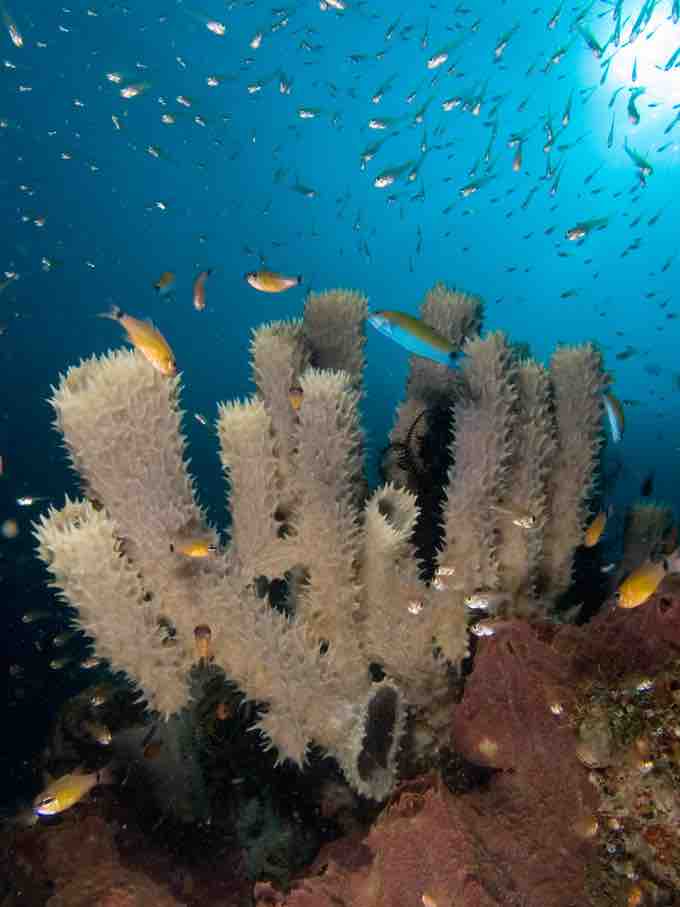The marine environment supplies many kinds of habitats that support life. Marine life partially depends on the saltwater that is in the sea ("marine" comes from the Latin "mare," meaning sea or ocean). A habitat is an ecological or environmental area inhabited by one or more living species .

Marine Habitats
Coral reefs provide marine habitats for tube sponges, which in turn become marine habitats for fishes.
Marine habitats can be divided into coastal and open ocean habitats. Coastal habitats are found in the area that extends from as far as the tide comes in on the shoreline, out to the edge of the continental shelf. Most marine life is found in coastal habitats, even though the shelf area occupies only seven percent of the total ocean area. Open ocean habitats are found in the deep ocean beyond the edge of the continental shelf.
Alternatively, marine habitats can be divided into pelagic and demersal habitats. Pelagic habitats are found near the surface or in the open water column, away from the bottom of the ocean. Demersal habitats are near or on the bottom of the ocean. An organism living in a pelagic habitat is said to be a pelagic organism, as in pelagic fish. Similarly, an organism living in a demersal habitat is said to be a demersal organism, as in demersal fish. Pelagic habitats are intrinsically shifting and ephemeral, depending on what ocean currents are doing.
Marine habitats can be modified by their inhabitants. Some marine organisms, like corals, kelp, mangroves and seagrasses, are ecosystem engineers, which reshape the marine environment to the point where they create habitats for other organisms.
Marine habitats include coastal zones, intertidal zones, sandy shores, rocky shores, mudflats, swamps and salt marshes, estuaries, kelp forests, seagrasses, and coral reefs. In addition, in the open ocean there are surface waters, deep sea and sea floor.
Intertidal zones (those areas close to shore) are constantly being exposed and covered by the ocean's tides. A huge array of life lives within this zone.
Sandy shores, also called beaches, are coastal shorelines where sand accumulates. Waves and currents shift the sand, continually building and eroding the shoreline. Longshore currents flow parallel to the beaches, making waves break obliquely on the sand. These currents transport large amounts of sand along coasts, forming spits, barrier islands and tombolos. Longshore currents also commonly create offshore bars, which give beaches some stability by reducing erosion.
The relative solidity of rocky shores seems to give them a permanence compared to the shifting nature of sandy shores. This apparent stability is not real over even quite short geological time scales, but it is real enough over the short life of an organism. In contrast to sandy shores, plants and animals can anchor themselves to the rocks.
Mudflats are coastal wetlands that form when mud is deposited by tides or rivers. They are found in sheltered areas such as bays, bayous, lagoons, and estuaries. Mudflats may be viewed geologically as exposed layers of bay mud, resulting from deposition of estuarine silts, clays and marine animal detritus. Most of the sediment within a mudflat is within the intertidal zone, and thus the flat is submerged and exposed approximately twice daily.
Mangrove swamps and salt marshes form important coastal habitats in topical and temperate areas respectively. An estuary is a partly enclosed coastal body of water with one or more rivers or streams flowing into it, and with a free connection to the open sea.
Kelp forests are underwater areas with a high density of kelp. They are recognized as one of the most productive and dynamic ecosystems on Earth. Smaller areas of anchored kelp are called kelp beds. Kelp forests occur worldwide throughout temperate and polar coastal oceans.
Seagrasses are flowering plants from one of four plant families which grow in marine environments. They are called seagrasses because the leaves are long and narrow and are very often green, and because the plants often grow in large meadows, which look like grassland.
Reefs comprise some of the densest and most diverse habitats in the world. The best-known types of reefs are tropical coral reefs, which exist in most tropical waters; however, reefs can also exist in cold water. Reefs are built up by corals and other calcium-depositing animals, usually on top of a rocky outcrop on the ocean floor. Reefs can also grow on other surfaces; this has made it possible to create artificial reefs. Coral reefs also support a huge community of life, including the corals themselves, their symbiotic zooxanthellae, tropical fish, and many other organisms.